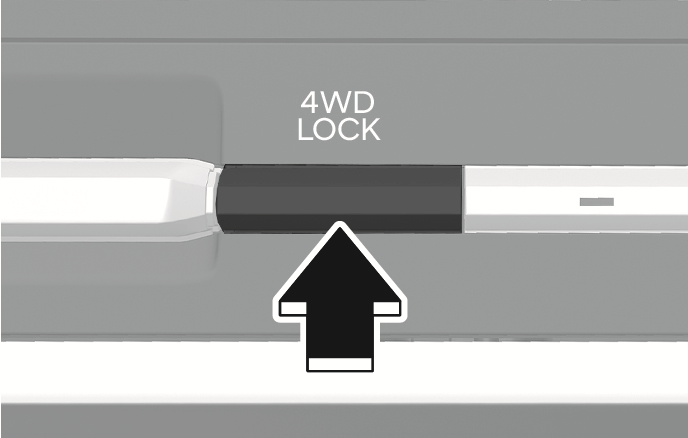Four wheel drive (4WD) mode

2C_4WDLockButton
|
Transfer mode |
Indicator light |
Description |
|
4WD AUTO (4WD LOCK is deactivated) |
(not illuminated) |
|
|
4WD LOCK |
(illuminated) |
|
If the 4WD (
-
Maintain the 4WD Auto mode when driving on roads in normal conditions.
-
Driving on normal roads with the 4WD Lock mode on, especially when cornering may cause mechanical noise or vibration. Driving in this mode for prolonged periods may damage parts of the power train. The noise and vibration disappear when the 4WD Lock mode is deactivated.
When the 4WD Lock mode is deactivated, a sensation may be felt as the driving power is delivered entirely to the front wheels.
If the 4WD system determines there is a need for four wheel drive, the engine’s driving power is distributes to all four wheels automatically.
Before driving
Make sure all passengers always wear their seat belts.
Driving on snow-covered or icy roads
-
Start off slowly by applying the accelerator pedal gently.
-
Use snow tires or tire chains.
-
Keep a sufficient distance between your vehicle and the vehicle in front.
-
Use engine braking during deceleration.
-
Avoid speeding, rapid acceleration, sudden brake applications, and sharp turns to prevent skids.
Driving in sand or mud
-
Maintain slow and constant speeds.
-
Use tire chains when driving in mud if necessary.
-
Keep a sufficient distance between your vehicle and the vehicle in front.
-
Reduce the vehicle speed and always check the road condition.
-
Avoid speeding, rapid acceleration, sudden brake applications, and sharp turns to prevent getting stuck.
When the vehicle is stuck in snow, sand, or mud, place a non-slip material under the drive wheels to provide traction OR slowly spin the wheels in forward and reverse causing a rocking motion that may free the vehicle. Avoid running the engine continuously at high RPM to prevent damage to the 4WD system.
Driving up or down hills
-
Driving uphill
-
Before starting off, check if it is possible to drive uphill.
-
Drive as straight as possible.
-
-
Driving downhill
-
Do not change gears while driving downhill. Select a gear before driving downhill.
-
Drive slowly when using engine braking while driving downhill.
-
Drive straight as possible.
-
-
Exercise extreme caution driving up or down steep hills. The vehicle may roll over in the grade, terrain, and water/mud conditions.
-
Do not drive across steep hills. A slight change in the wheel angle may destabilize the vehicle. A stable vehicle may lose stability if the vehicle stops its forward motion. Your vehicle may roll over, resulting in a serious injury or death.
Driving through water
-
Try to avoid driving in deep standing water. It may stall your engine and clog your exhaust pipes.
-
If you need to drive in water, stop your vehicle, set the vehicle in 4WD Lock mode, and drive under 5 mph (8 km/h).
-
Do not change gears while driving in water.
Additional driving conditions
-
Become familiar with the off-road conditions before driving.
-
Always pay attention when driving off-road and avoid dangerous areas.
-
Drive slowly when driving in heavy wind.
-
Reduce vehicle speed when cornering. The center of gravity of 4WD vehicles is higher than conventional 2WD vehicles. The vehicle is more likely to roll over if you turn the steering wheel too quickly.
-
Always hold the steering wheel firmly when you are driving off-road.
Do not grab the inside of the steering wheel when you are driving off-road. You may hurt your arm by a sudden steering maneuver or from steering wheel rebound due to an impact with objects on the ground. You may lose control of the steering wheel that may lead to serious injury or death.